Latest building and what does it have to do with lions?
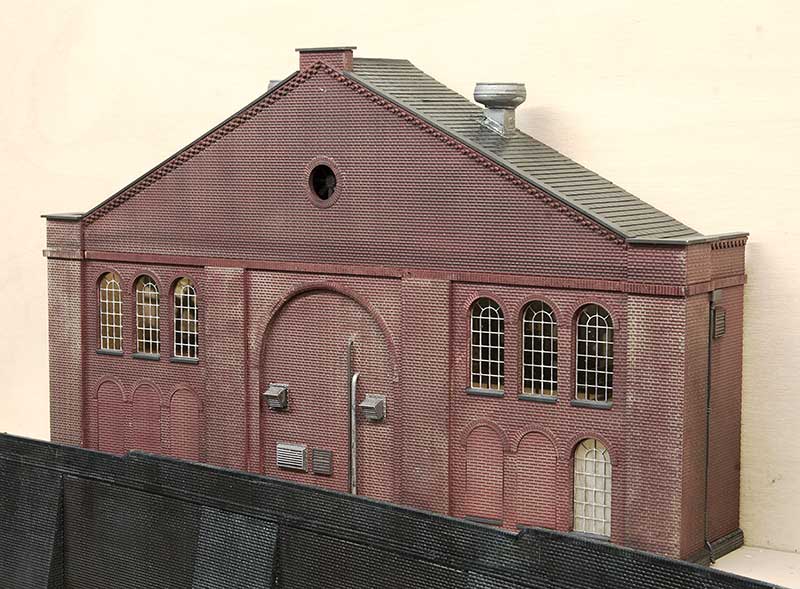 This is my latest building for Brettell road and likely to be the last but one physical model building for the layout. I have plenty more buildings to create yet but as those will be on the backscene they will need to be illustrated instead.
This is my latest building for Brettell road and likely to be the last but one physical model building for the layout. I have plenty more buildings to create yet but as those will be on the backscene they will need to be illustrated instead.
As usual it takes its inspiration from a local structure and this time its the Lion Health building in Stourbridge. Or at least a bit of it. Construction is the same as the others featured recently so I wont go over old ground again. Before it was a health centre the Lion Health building was an Ironworks built by Foster, Rastrick and Company in 1821. John Urpeth Rastrick was originally from Morpeth and had previously constructed an early railway locomotive for Richard Trevithick in 1808. The company would continue to produce steam engines as well as proving machines for chain cable, saws, mills, and boilers. It also produced structural components for buildings, bridges and gas works and in 1825 it listed railway components in a catalogue of products including rail, sleepers and chairs. Its fourth locomotive, Agenoria, was built for the Earl of Dudley’s railway and it survives to this day at the National Railway Museum. The company fared far worse than Agenoria and it was officially dissolved on 20 June 1831 and it was absorbed into the Stourbridge Iron Works of John Bradley & Co. James Foster was already the major partner (John Bradley was his half brother) and after 1832 James became the sole owner.
The site went through several more owners but they kept the name John Bradley & Co. (Stourbridge) Ltd. The first was when, in 1919, the Stourbridge Iron Works were sold to a company owned by Edward J. Taylor and then in the interwar period, N. Hingley & Sons Ltd took over but it still continued to trade under the John Bradley & Co name until 1963. The company was finally wound up in 1966 but the Stourbridge Ironworks continued as a rolling mill within the F.H. Lloyd Group until 1982. The building became derelict was nearly destroyed completely due to a fire in 2004. In 2012 it was renovated to become Lion Health which opened in 2014. In 2009 a couple of urban explorers managed to get in and took some pictures, these can be seen here.
What have lions got to do with any of this?
In 1829 Foster, Rastrick and Company built a locomotive for the Delaware & Hudson Canal Company in the USA and this loco, Lion, or rather the Stourbridge Lion is noted to be one of the first foreign built locomotives to be operated in the United States, and one of the first locomotives to ever operate outside Britain. The locomotive performed well in its first test in August 1829 but was found to be too heavy for the track and was never used for its intended purpose of hauling coal trains. Parts of this locomotive also survive and are on display at the B&O Railroad Museum in Baltimore.
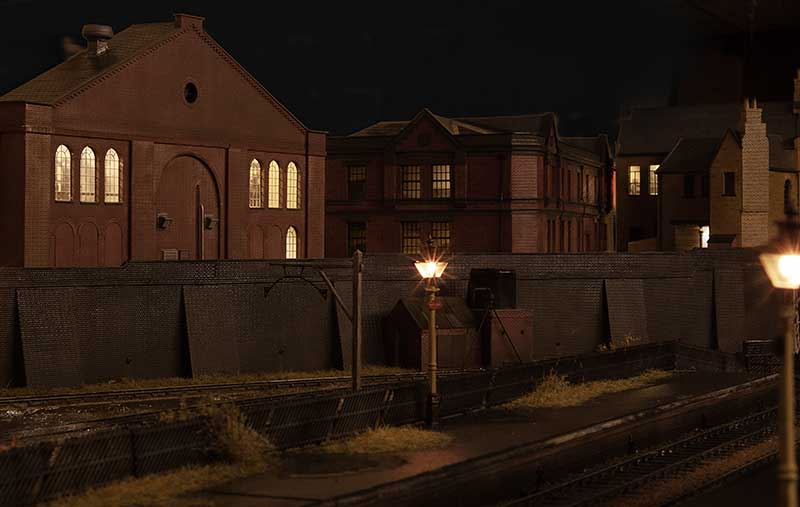 A view from the platform. I think i’ll tone the lighting down a bit more.
A view from the platform. I think i’ll tone the lighting down a bit more.
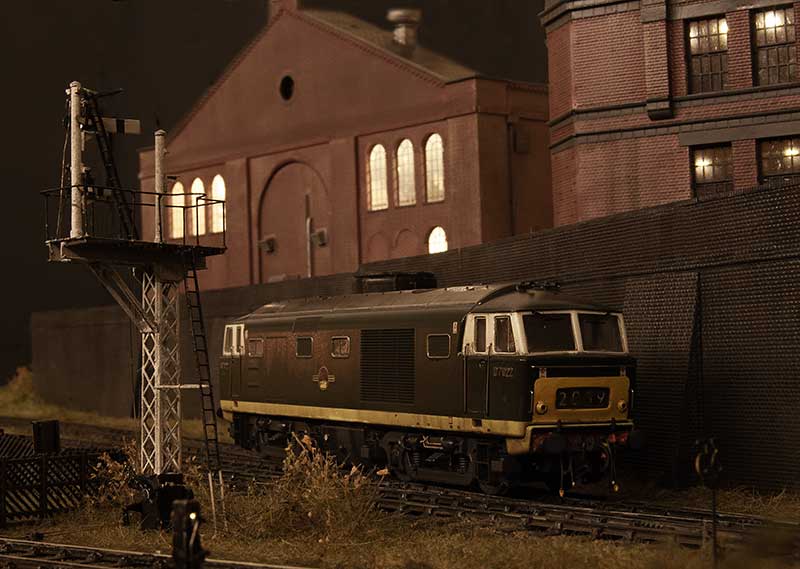 The recently completed Hymek trundles past.
The recently completed Hymek trundles past.
Below are a couple of overall layout shots which I think captures the wet look I’m after. The last one from my phone so apologies for the lack of depth of field.
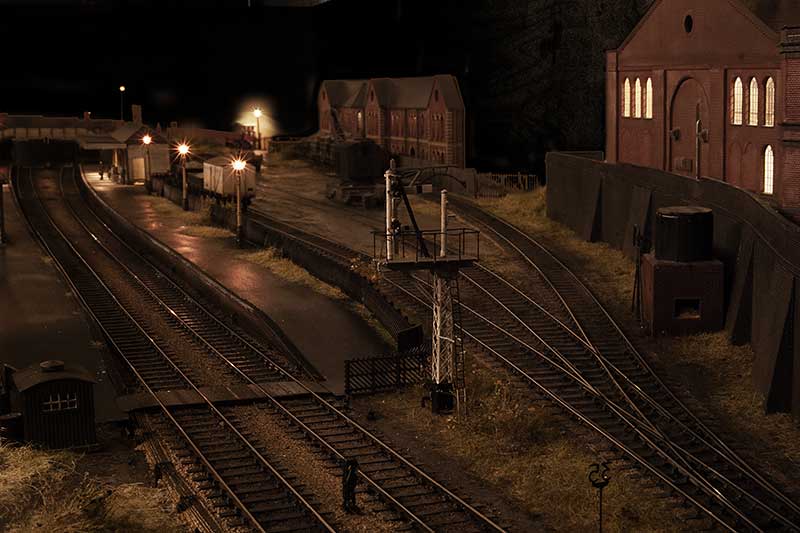
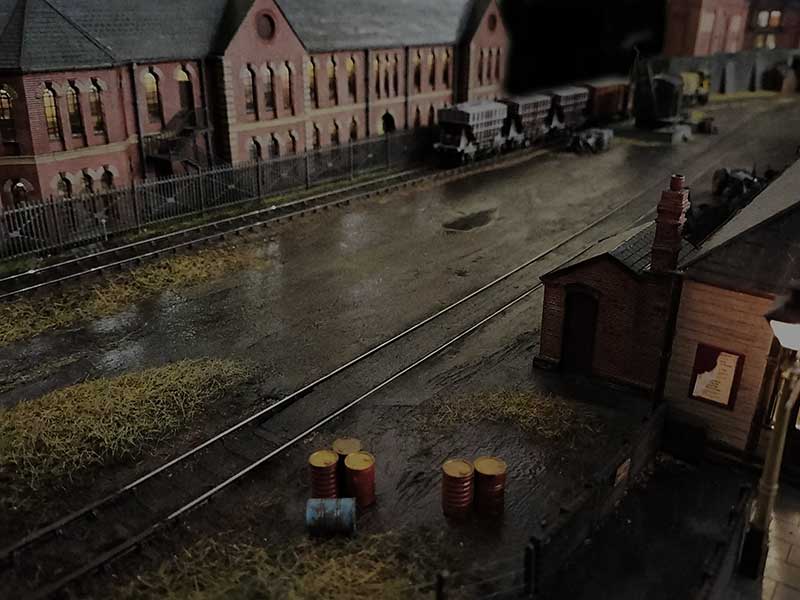
One of those finished things posts.
The advantages of working on more than one project at once is that, firstly, I don’t get bored and secondly every so often you seem to finish a lot of things together. This is one of those instances with several things that have featured recently have reached the finish line sort of together.
 My loading gauge has been painted for a while but now its been planted too. I love stuff like this as its one of those things that I hope disappears into the scene and becomes unremarkable. Perhaps once in a blue moon someone will notice it but, much like the real thing I like stuff like this just to be ‘there’. It’s not supposed to get people’s attention. (don’t worry about the big gap under the wall – that’s not been permanently attached yet)
My loading gauge has been painted for a while but now its been planted too. I love stuff like this as its one of those things that I hope disappears into the scene and becomes unremarkable. Perhaps once in a blue moon someone will notice it but, much like the real thing I like stuff like this just to be ‘there’. It’s not supposed to get people’s attention. (don’t worry about the big gap under the wall – that’s not been permanently attached yet) My Ford Thames and Austin A40. The colours of the Austin have a somewhat obvious Birmingham influence. Cartwrights was a furniture store in Brierley Hill but I have no idea if they used Austin vans or even if they had any road vehicles at all.
My Ford Thames and Austin A40. The colours of the Austin have a somewhat obvious Birmingham influence. Cartwrights was a furniture store in Brierley Hill but I have no idea if they used Austin vans or even if they had any road vehicles at all.  This was a quick win project – Started life as a Bachmann Coke wagon which I imagined was sold to Round Oak and had the coke rails removed. I just liked it because it had a local livery and i’ve never done a distressed private owner before. The lettering was attacked with one of those brass brush wheels in a mini-drill and then the wagon was weathered. The w-irons needed a but more work with the mini-drill and a burr to get the wheels in but this was really minimal effort modelling!
This was a quick win project – Started life as a Bachmann Coke wagon which I imagined was sold to Round Oak and had the coke rails removed. I just liked it because it had a local livery and i’ve never done a distressed private owner before. The lettering was attacked with one of those brass brush wheels in a mini-drill and then the wagon was weathered. The w-irons needed a but more work with the mini-drill and a burr to get the wheels in but this was really minimal effort modelling!  And so to the big project of the last few weeks – the DE2 shunter. I have to admit I didn’t relish the thought of painting its striped livery but by using some 4mm making tape from a company called Jammy Dog it wasn’t too bad at all. (click here for their website) A few more pictures below.
And so to the big project of the last few weeks – the DE2 shunter. I have to admit I didn’t relish the thought of painting its striped livery but by using some 4mm making tape from a company called Jammy Dog it wasn’t too bad at all. (click here for their website) A few more pictures below.

 This is the sort of train I had in mind for the loco – Pushed up the hill with the loco at the rear and no brake van. I will need to add a shunter to the front wagon at some point.
This is the sort of train I had in mind for the loco – Pushed up the hill with the loco at the rear and no brake van. I will need to add a shunter to the front wagon at some point.
 Finally another moody shot of the Jinty heading out of the yard on a train of vans.
Finally another moody shot of the Jinty heading out of the yard on a train of vans.
What is down those ramps?
 On the surface the ramps towards the western end of New Street were used for transporting mail and other services between platforms. If you ever visited the station when BRUTE trolley’s were in use you could often see trains of them appearing from the gloom. Its one of the reasons that the more common 3 wheeled Lansing Bagnall TOER platform tugs lost out to the more heavy duty Reliance Mercury types as depicted above. However the story goes a bit further than that in that there was (is) quite a subterranean underground system under the city centre. From the platforms of New Street mail could get directly to the mailbox without ever seeing daylight via quite a substantial tunnel. Occasionally this is opened to the public and more can be seen here
On the surface the ramps towards the western end of New Street were used for transporting mail and other services between platforms. If you ever visited the station when BRUTE trolley’s were in use you could often see trains of them appearing from the gloom. Its one of the reasons that the more common 3 wheeled Lansing Bagnall TOER platform tugs lost out to the more heavy duty Reliance Mercury types as depicted above. However the story goes a bit further than that in that there was (is) quite a subterranean underground system under the city centre. From the platforms of New Street mail could get directly to the mailbox without ever seeing daylight via quite a substantial tunnel. Occasionally this is opened to the public and more can be seen here
What is Anchor?
As kids we all thought the ramps led to a top secret nuclear bunker and that’s not actually all that far from the truth as there is indeed a hardened facility under Birmingham, built in the event of an atomic attack. Its one of 3 during the 1950’s, designed to house and shield communication systems from a Hiroshima sized atomic weapon exploding nearby (although it would never have survived a direct hit). It was called Anchor after the hallmark of Birmingham’s Assay Office. The other bunkers were Guardian in Manchester and Kingsway in London. Anchor is the largest of the 3. There is a rumour of a 4th facility under Glasgow but no evidence that it ever existed has ever come to light.
It was built under the cover story of Birmingham’s underground railway system and cost £4 million pounds. The public were later told that the underground system was not viable and had been abandoned but Anchor was completed in September 1957 and was soon automatically handling 250,000 calls a day. The main site is located underneath the BT tower on Newall Street. The construction site entrance for Anchor was located opposite Moor Street station and later became public underpass.
The main tunnel at Anchor was roughly the same size and shape as those used on the London underground and went out to Hill Street and then to Essex Street passing under New Street station. It is not clear if the anchor tunnels and the Post office tunnels are actually linked together but some ex postal workers have stated that they could get from New Street to the other post office at the top of hill street via the tunnels. It is also claimed that the mysterious heavy duty and strangely small, door that was part of the LNWR stables building at the end of platform 1 was also linked to a tunnel that took you to Hill Street.  Anchor had its own water supply in the form of a 300 ft deep well under the site as well as the obvious air filtration systems but it was only ever designed to keep communications running and not as the site of the salvation of the Brummy masses, the idea of some huge facility that can house the population at the end of the world, anywhere in the world is probably nothing more than Hollywood myth and wishfull thinking. Indeed the air systems were as much to keep the air cooled machines running as anything else. The main entrance was via a lift at the back of Telephone house (between Fleet street and Lionel Street) and the entrance was protected with blast doors.
Anchor had its own water supply in the form of a 300 ft deep well under the site as well as the obvious air filtration systems but it was only ever designed to keep communications running and not as the site of the salvation of the Brummy masses, the idea of some huge facility that can house the population at the end of the world, anywhere in the world is probably nothing more than Hollywood myth and wishfull thinking. Indeed the air systems were as much to keep the air cooled machines running as anything else. The main entrance was via a lift at the back of Telephone house (between Fleet street and Lionel Street) and the entrance was protected with blast doors.
Anchor was only ever put on full alert during the Cuban missile crisis and was officially declassified in the late 1960’s with various members of the press being allowed to visit the site.
Such was the pace of Nuclear weapon development that all 3 exchanges were obsolete before they were even completed but Anchor continued to remain operational until the late 1980’s. Its is now, reportedly, abandoned and suffers regular flooding from Birmingham’s rising water table (the result of the decline of heavy industry in the area)
So whats left?
The main site is still there unless the recent closing of the underpasses was a cover for somehow removing it or filling it in, unlikely givent the timescales. There is still some evidence of its existence above ground.  On the left one of the ventilation shafts which can be seen from the A38. On the right a mysterious but very secure looking BT doorway virtually opposite the entrance to Snow Hill station which is sometimes said to be an entrance. I have to admit, that while i know no better the concrete looks far too new for something supposedly built so long ago. There is also a goods lift still visible on Lionel Street.
On the left one of the ventilation shafts which can be seen from the A38. On the right a mysterious but very secure looking BT doorway virtually opposite the entrance to Snow Hill station which is sometimes said to be an entrance. I have to admit, that while i know no better the concrete looks far too new for something supposedly built so long ago. There is also a goods lift still visible on Lionel Street.
